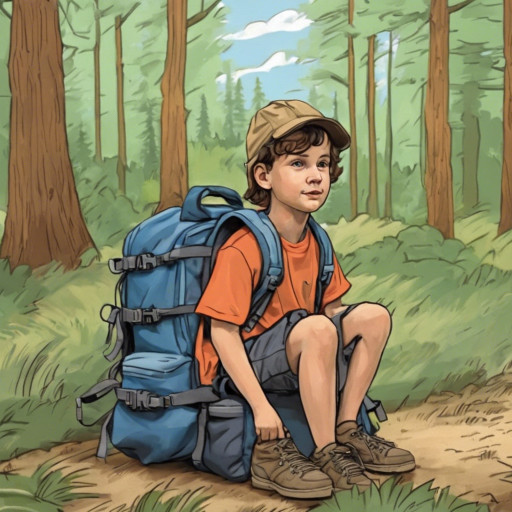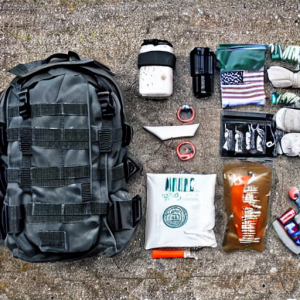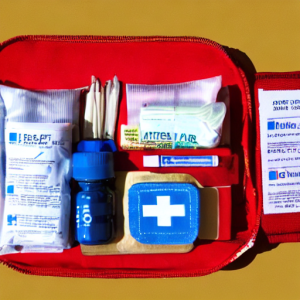A Comprehensive Guide to Packing Bug Out Bags for Children
The first responsibility we have as parents is to ensure the well-being and security of our offspring. Though we hope for the best, it is crucial to be prepared for any unforeseen tragedies or disasters that can occur. An essential element of any disaster preparedness strategy is a bug out bag, which is a compilation of essential supplies meant to keep you and your family alive until help arrives. Our focus for today is going to be on a subject that is often overlooked: making kid-friendly bug out bags. Providing you with all the information you need to prepare bug out bags especially for your kids is the goal of this comprehensive tutorial.

Why Are Bug Out Bags for Children Important?
Children's fragility is something that needs to be specifically considered in disaster preparedness during times of crisis. The concept of kid-friendly bug out bags stems from a basic need to ensure the security and welfare of our communities' younger residents in the case of unforeseen circumstances. We offer children the opportunity to actively participate in securing their safety by thoughtfully assembling these kid-specific survival kits, which also serve to relieve some of the burden on carers in case of an emergency.
Children often turn to adults for solace when faced with challenging circumstances because they rely on their parents or guardians for guidance and security. During emergencies, adults may be required to do a range of crucial tasks, such as planning evacuation routes, making decisions, and disseminating information. A carefully packed bug out bag for a child is an essential tool when it comes to making sure they can survive challenging situations on their own, at least for a certain duration.
The idea of bug out bags for kids has more meaning than just providing essential survival gear; it also has an empowering connotation. It makes it easier for young people to build resilience and a sense of responsibility. Not only do kids feel more prepared for unforeseen circumstances when they have their backpacks with them, but they also gain some measure of control over the environment around them. This sense of agency can help a child feel more secure and capable of handling challenging situations, which can improve their emotional health during times of crisis.
Children demand different things from adults in terms of their bodily needs. Because of this, they have different food requirements. Their bodies are still developing. Children's bug out bags should therefore contain a variety of age-appropriate food, clothing, and medical supplies. Products like formula, diapers, or certain medications that are made to fit the unique needs of little children need to be given extra consideration. This customisation adds to the child's overall comfort and health by ensuring that their physical demands are satisfied during trying times.
Youngsters experience stress in different ways than adults do, both psychologically and emotionally. It is critical to acknowledge the psychological health of children in disaster situations, and the addition of comfort items to bug out packs serves this purpose. Anxiety and fear might be lessened by the child's familiar toys, a beloved blanket, or other items that are meaningful to them. These things can offer a source of comfort and stability. One way to increase the holistic approach to emergency preparedness is to include the psychological needs of children while creating bug out bags for them.
The inclusion of age-appropriate items in a child's bug out bag serves as a reminder that emergency preparedness is not a universally applicable idea. Just as we consider the unique needs of those with disabilities or health conditions, we also need to recognise that youngsters need a particular approach when it comes to preparation. By offering bug out bags that are especially made to satisfy the needs of our younger community members, we make sure that they are not overlooked during the emergency preparation process.
Choosing the Right Bug Out Bag

Consideration should be given to both the practicality and comfort level of a bag when choosing one that meets a child's needs for a bug out. The right rucksack must be chosen to guarantee that the youngster can carry their emergency supplies in a way that is both practical and efficient. This will support the child's overall well-being despite challenging circumstances.
Numerous compartments are a crucial component of functionality, making them one of the most significant qualities to look for in a backpack. These compartments offer a useful solution to the organisation challenge by enabling the methodical arrangement of a variety of goods. A well-organized bag allows you to swiftly and easily access essential things, which is why owning one of these bags is crucial in an emergency. The ability to divide up resources such as food, drink, clothes, and first aid kits not only streamlines the retrieval process but also ensures that resources are used wisely in the critical early stages of a disaster.
The other equally important consideration is assessing how well the rucksack fits and whether or not it is appropriate for the child's physical build. A poorly fitting backpack could put the child through stress, discomfort, and possibly put them at risk for health issues. Because of this, parents and other carers must be aware of the rucksack's overall design, weight distribution, and dimensions. It's crucial to search for features like adjustable straps so that the fit may be customised to the child's height and shape. This change not only improves the comfort level of the bag but also lessens the likelihood of injury or physical strain for the child, making it easier for them to carry.
Beyond just making sure the child is physically comfortable, a well-fitting knapsack affects the youngster's sense of confidence and their capacity to move swiftly and confidently during an emergency evacuation. When a bag fits properly, it ensures that the youngster can move around with stability and balance. In a situation that may otherwise be chaotic, this helps to create a feeling of security and control. The integration of ergonomic design and functional consideration is a crucial element of the comprehensive readiness plan for children.
Parents must involve their children in the decision-making process, considering their comfort level and preferences. If the experience is made collaborative, children are more likely to embrace the responsibility of owning their bug out bag. Incorporating children into the decision-making process also serves to empower them and strengthen their sense of ownership over emergency supplies.
Ensuring Proper Hydration
The importance of ensuring that children are appropriately hydrated cannot be overstated when it comes to emergency preparedness. Because it's essential to sustaining health and wellbeing in an emergency, staying well hydrated is much more vital than it is at this time. Making sure that water-related items are at the top of your list of priorities when packing your child's bug out bag becomes a crucial component of their preparedness strategy.
A proactive strategy would be to make sure your child always has access to a portable and dependable source of water. This might be as simple as packing a kid-specific hydration pack or a lightweight water bottle. Choosing the right container involves more than just convenience; it also involves taking children's unique needs and talents into account. To encourage youngsters to take charge of maintaining their water supply in an emergency, make sure the design you choose is easy for them to handle and transport.
Furthermore, the addition of a hydration pack has a twofold function: it facilitates children's ability to carry water without using their hands and adds to their enjoyment of the sport. These packs transform a basic necessity into an accessory that is more alluring and promotes regular water drinking because they are usually designed with vibrant colours and kid-friendly features.
During the process of packing the water supplies, use this as an opportunity to teach your child the importance of staying properly hydrated. Teaching children the value of water in maintaining their health is crucial, particularly when they are going through challenging times. Emphasise the importance of drinking enough water to sustain body functions and quench thirst, especially before, during, and after physical exertion. Water holds great significance for these two reasons.
Talking to your child about the signs that they are becoming dehydrated is just as important as emphasising the need of drinking water regularly. Children can take control of checking their hydration levels and taking preventative action when they are taught to notice symptoms including fatigue, dizziness, and dark urine. Learning these skills gives kids a vital set of abilities that let them take charge of their health and effectively communicate their needs, even in the wake of an emergency.
One of the most crucial things to do to prepare kids for unforeseen circumstances is to promote a proactive and informed approach to staying hydrated. By incorporating these lessons into the process of assembling their bug out bag, you will not only satisfy their immediate needs but also provide children with essential life skills that will gradually give them more power. It becomes imperative to focus on hydration when trying to help kids develop resilience, self-sufficiency, and responsibility as they deal with unanticipated situations.
Nutrition and Food Supplies
A child’s food intake has a big effect on their general health, especially when they are faced with stressful situations. Non-perishable food supplies are a crucial component to include while meticulously assembling your child's bug out pack. This guarantees that your child will receive the nutrition they need even in the event of unanticipated issues.

Choosing foods that are both diversified and nourishing should be your top priority when it comes to packing your bug out bag. Because they are easy to eat and don't need to be refrigerated, granola bars, fruit snacks, and meal replacement bars are all seen as practical choices. These products not only give kids the essential nutrients they require, but they also offer a portable and easy way to keep kids' energy levels up when they're in need.
It's crucial to keep in mind that highlighting nutritional value does not mean sacrificing flavour when it comes to pleasing kids' sophisticated palates. Select remedies that will not only satisfy the palates of the youth but also promote good health. This careful choice makes it easier for kids to take the food that is provided when things are tough, which is good for their physical and emotional well-being.
A smart strategy could include incorporating a wide array of foods that can meet different dietary requirements. Granola bars could provide you a quick boost of energy and carbohydrates, but fruit snacks are said to be better because they have important vitamins and minerals in them. Meal replacement bars, on the other hand, may be able to provide a more thorough nutritional profile, ensuring that the youngster using them will get a balanced diet. The different needs of a developing and growing body are met as a result of this diversity, which highlights the importance of keeping a balanced diet even in an emergency.
To make sure the bug out bag is useful over time, it is crucial to check its expiration dates frequently. It's important to remember that “non-perishable” does not always equate to “indefinite freshness.” Replacing food items that are approaching expiration date is a proactive way to make sure your child always has access to a range of healthy and safe options. Furthermore, this regimen makes it possible to adapt to the child's constantly shifting dietary needs and preferences.
These foods not only help children facing challenging situations meet their bodily demands, but they also significantly contribute to lowering stress levels and restoring a sense of normalcy in their lives. Children can find comfort in familiar snacks, which helps them with the unpredictable nature of emergencies. Your child's bug out bag contains non-perishable food items that are carefully chosen and regularly restocked. By doing this, you not only provide for their immediate nutritional needs but also support their mental health in emergency situations. This all-encompassing approach to eating emphasises the value of considering a child's physical and mental well-being in the context of disaster preparedness.
Clothing and Protective Gear
When you are packing a thorough bug out bag for your child, being mindful of the clothes they carry becomes crucial to their feeling of preparedness. Incorporating additional clothing appropriate for the local environment and weather is not just a comfort issue but also a crucial step towards guaranteeing their safety and well-being in case of dire circumstances.
Think on the small things, such packing extra socks and trousers, which are often overlooked needs but may significantly impact a child's comfort level. These products are not only necessary for maintaining hygiene but also for promoting a sense of routine and wellbeing, which is particularly crucial in trying times. Another adaptable item that can be worn in a range of circumstances is a warm hat. It provides insulation and weather protection, especially during colder months.
 The provisions for clothes go beyond the fundamentals, and the selection should be influenced by the age of your child, the size of your child, and the particular weather patterns that are usual in your region. If you have younger children, you should think about carrying rain gear to protect them from sudden downpours. In colder climates, gloves can be extremely useful since they protect young hands from the harmful effects of cold temperatures. To guarantee the child’s mobility and safety during evacuation scenarios, it is vital to provide them with sturdy shoes that are suited for walking or potentially traversing a variety of terrain.
The provisions for clothes go beyond the fundamentals, and the selection should be influenced by the age of your child, the size of your child, and the particular weather patterns that are usual in your region. If you have younger children, you should think about carrying rain gear to protect them from sudden downpours. In colder climates, gloves can be extremely useful since they protect young hands from the harmful effects of cold temperatures. To guarantee the child’s mobility and safety during evacuation scenarios, it is vital to provide them with sturdy shoes that are suited for walking or potentially traversing a variety of terrain.
Children grow older and have a greater need for clothing. The clothing in the bug out bag needs to be regularly reviewed and updated to account for their constantly changing size and needs. An article of clothing that fits well not only provides comfort, but it also facilitates movement—a crucial attribute to have in case of an emergency, when quickness and mobility may be required.
The variables that need be taken into account when choosing clothing get more complex as the seasons change. An appropriate solution in one season might not be enough in another. As a result, the contents of the bug out bag must be changed based on the season. You can be confident that your child will be adequately prepared for a variety of weather situations thanks to this versatility, whether it is the intense summer heat or the chilly, rainy winter months.
Comfort Items and Entertainment
Understanding the emotional toll that emergencies take on kids emphasises how important it is to provide comforting items in their bug out bag. Having items that provide a sense of stability and familiarity becomes crucial when it comes to assisting their mental health amid uncertain times. This is on top of the physically existent necessary supplies and provisions.
When you are preparing your child's bug out bag, remember how much comfort your youngster gets from their favourite stuffed animal. This adorable buddy serves as more than just a plaything when faced with uncertainty; it becomes a source of consolation and assurance for the person who receives it. Similarly, a small blanket can offer mental solace as well as physical warmth, acting as a comforting familiar object in the chaos that arises from catastrophes.
It could be comforting for a child to have a special book in their bug out pack. Because familiarity acts as a potent antidote to fear, pack a book that the child has always adored. A well-known story can serve as a stabilising force amid disruption by giving people a feeling of continuity and stability. This holds true regardless of whether the story is a beloved picture book or a wonderful bedtime read.
In addition, it's a smart move to include games, puzzles, or other small-scale activities to keep kids occupied and distracted from potentially upsetting things going on in their environment. These distractions have two purposes: they provide as a constructive outlet for tension or pent-up energy in addition to being a form of entertainment. They are made to serve these two functions. When confronted with challenging circumstances, colouring books, small puzzles, or easy card games might offer a pleasant diversion and help the person see things more positively.
Comfort items have a profound psychological impact that cannot be overstated. When under stress, children may benefit tremendously from tangible reminders of normalcy. These items serve as anchors for kids, giving them a sense of comfort and stability when everything else seems chaotic and unpredictably changing. They are more than just distractions.
The deliberate selection of comfort items for a child's bug out bag shows a caregiver's commitment to meeting both the child's physical and emotional needs. To protect the child's mental health, this is required. It shows that someone understands the unique issues that kids face in emergencies and how important it is to give them the tools they need to overcome these challenges in a resilient and secure manner. In the end, these comfort items support the all-encompassing approach to emergency preparedness for kids, which acknowledges and attends to both the kids' practical and emotional requirements.
Essential Supplies
 Not only should the goods that were listed above be included in every bug out bag for children, but there should also be other important supplies included. In the event of an emergency, each of these items will contribute to ensuring their safety and well-being. Included on this list of necessary goods is a checklist:
Not only should the goods that were listed above be included in every bug out bag for children, but there should also be other important supplies included. In the event of an emergency, each of these items will contribute to ensuring their safety and well-being. Included on this list of necessary goods is a checklist:
1. First Aid Kit: Any bug out bag needs to contain a first aid kit that is adequately equipped. Include any required drugs or specialized medical supplies that your child requires, as well as band-aids, antiseptic wipes, gauze pads, and an emergency blanket.
2. Personal Identification and Contact Information: Make sure to include a laminated card with your child’s name, address, emergency contacts, and any other important medical information if you become separated from them.
3. Flashlight and Batteries: In low-light situations, having a portable torch that is both comfortable and helpful can be of great use. LED flashlights are a better option because they are not only lightweight but also have a longer battery life.
4. Personal Hygiene Items: Bring along travel-sized versions of your personal care items, like hand sanitizer, toothpaste, toothbrush, and soap. The incorporation of these things will assist in the maintenance of hygiene and the prevention of the transmission of germs.
5. Whistle: Instruct your youngster on the significance of drawing attention to themselves when it is required. By including a whistle in their bug out bag, they will be able to signal for assistance in the event of an emergency emergency.
6. Cash and Important Documents: Be sure to include copies of crucial documents, such as birth certificates, passports, and insurance information, as well as a modest quantity of cash in small denominations.
7. Emergency Contact List: A laminated list of emergency contacts should be included, along with other pertinent information such as phone numbers, addresses, and instructions to secure meeting sites.
Educating Your Child
Assembling bug out bags is not an isolated activity; rather, it is reinforced by another equally significant element: imparting knowledge. Although the children receive material resources to assemble the bag, understanding its function and proper usage is crucial to their ability to react appropriately in the event of an emergency.
By spending the time to teach your child about the contents of their bug out bag, you are investing in their readiness and self-assurance. Eliminate any doubt regarding the purpose of any item by describing its usage. This encourages a sense of accountability and ownership over their emergency pack in addition to helping kids become more familiar with the resources at their disposal. When kids know how to use every item in the bug out bag, it turns from being a mysterious collection of items into a resource they can actively employ, which empowers them.
Regular exercises or simulations are a frequent practice to further reinforce the practical information learned during the educational phase. These drills provide kids the chance to apply what they've learned in an emergency, which helps them solidify their understanding of how important it is to remain calm and follow directions. Simulations come in a variety of forms, from simple exercises like learning how to appropriately put on a rain poncho to more intricate ones like evacuating a particular area. The aim is to instill in children a sense of familiarity and readiness so that, in the event of a real emergency, they can use the skills they have learned to manage the situation and stay composed.
Education plays a crucial role in shaping a child's mindset for emergencies, aside from the utilitarian needs of carrying a bug out bag. Teach children the value of remaining composed, emphasising that making better decisions and responding to others is made possible by having a clear head. You should discuss how crucial it is to follow instructions, whether they come from you, other caretakers, or individuals providing emergency aid. This foundation of knowledge allows the bug out bag to evolve from a basic assortment of items into a comprehensive tool kit that gives kids the physical and mental skills they need to overcome unforeseen challenges.
Creating a Routine
The efficacy of a child-specific bug out bag is contingent upon the caregiver's dedication to conducting routine inspections and modifications to sustain the bag's functionality. To make sure that the bag remains a trustworthy resource when needed, it is imperative to develop a practice for checking and restocking its contents. This practice not only helps your child overcome practical challenges, but it also gives them a sense of responsibility and helps them understand the need of being prepared.
As a preventative measure, the bug out bag should be routinely inspected to make sure its contents are current and functional. Checking for items that are damaged or have expired is crucial since these things can reduce the effectiveness of the supply. For example, medications that have run out of their expiration date or pills that filter water may not work as intended, making them less dependable in an emergency. By identifying and replacing such components during routine checks, the preparedness and reliability of the bag can be preserved.
Your child's involvement in this habit benefits them in several ways. First, it highlights the value of shared responsibility by emphasising that being prepared requires cooperation from all members of the organisation. Children can gain an understanding of the contents of the bug out bag and its importance through their involvement in the inspection procedure. The bag becomes an active tool that individuals are accountable for maintaining as a result of their involvement, changing from a passive emergency resource.
The second advantage is that your child will gain a sense of ownership for their level of preparation if they participate in the regular checks. Little ones actively participate in making sure the contents of the bag are current, which helps them internalise the idea that being prepared is a personal responsibility. Because children understand that they have actively contributed to their preparedness, this sense of ownership can translate into a more robust and confident mindset in emergencies.
Furthermore, the regular assessments provide an opportunity to continue the discussion about the adequacy of emergency plans. You should use these opportunities to go over the purposes of each item in the bag with them so that they can better understand how it contributes to their safety and well-being. Encourage open communication and probing questions to clear up any doubts or concerns they may have.
The post How to Pack Bug Out Bags for Kids appeared first on Survivalbite.
The Article How to Pack Bug Out Bags for Kids First Appeared ON
: https://ad4sc.com





Comments are closed